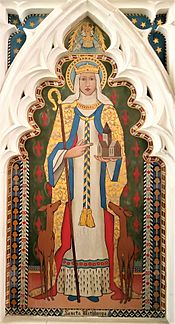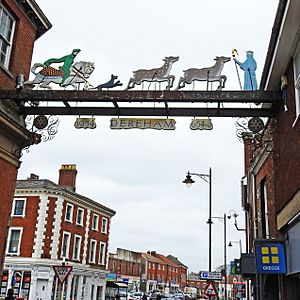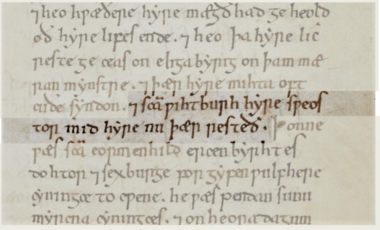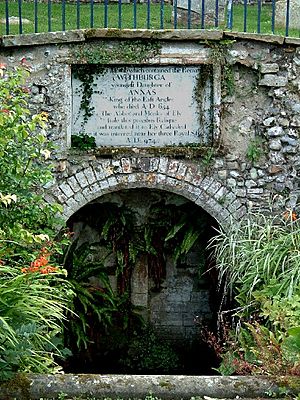Wihtburh facts for kids
Quick facts for kids Saint Wihtburh |
|
|---|---|

St. Wihtburh, depicted in St Nicholas's Church, Dereham, Norfolk
|
|
| Died | 17 March 743 Dereham |
| Venerated in | |
| Major shrine | Ely Cathedral |
| Feast | 8 July |
| Attributes | A pair of does; church |
|
Catholic cult suppressed
|
1540s |
Wihtburh (also Withburga or Withburge; died 743) was an East Anglian saint, princess and abbess. According to tradition, she was the youngest daughter of Anna, king of the East Angles, but Virginia Blanton has suggested that the royal connection was probably a fabrication. One story says that the Virgin Mary sent a pair of female deer to provide milk for Wihtburh's workers during the construction of her convent at Dereham, in Norfolk. When a local official attempted to hunt down the does, he was thrown from his horse and killed.
Withburh died in 743 and was buried at Dereham. Her body was said to be uncorrupted by age or decay when her tomb was opened half a century after her death, and the church and the tomb subsequently became a place of pilgrimage. When her relics were stolen on the orders of the abbot of Ely Abbey, the remains were re-interred at Ely next to her sisters Æthelthryth and Seaxburh. In 1106, Withburh's body was again examined and found to be intact.
Wihtburh’s cult in Eastern England, which was never large, was closely linked with that of her sister Æthelthryth. It was suppressed during the Reformation in the 1540s, and her relics were all destroyed.
Contents
Family
Wihtburh was supposedly one of the daughters of Anna of East Anglia, a son of Eni, a member of the Wuffingas dynasty, and a nephew of Rædwald, king of the East Angles from 600 to 625. East Anglia was an early and long-lived Anglo-Saxon kingdom that corresponds with the modern English counties of Norfolk and Suffolk. Due to their rivalry for control over the Middle Anglian people, East Anglia and its neighbour Mercia probably became hereditary enemies, and Mercia's king Penda repeatedly attacked the East Angles from the mid-630s to 654.
The sources for information about Wihtburh's family and the life and reign of Anna include the Historia ecclesiastica gentis Anglorum (Ecclesiastical History of the English People), completed in Northumbria by the English monk Bede in 731, and the Anglo-Saxon Chronicle, which dates the from 9th century. The Liber Eliensis, written at Ely in the 12th century, also provides information about Anna and his daughters.
Wihtburh is not mentioned by Bede, whose writings about her elder sisters Seaxburh of Ely, Æthelthryth, Æthelburh of Faremoutiers and Sæthryth, her older half-sister, indicate that he was well-informed about the family. References to Wihtburh first appear in 10th and 11th century records, and the medievalist Virginia Blanton has suggested that the connection between Wihtburh and the family of Anna is likely to be a fabrication, invented to enhance the status of Ely Abbey.
| Family of Wihtburh | ||||||||||||||||||||||||||||||||||||||||||||||||||||||||||||||||||||||||||||||||||||||||||||||||||||||||||||||||||||||||||||||||||||||||||||||||||||||||||||||||||||||||||||||||||||||||||||||||||||||||||||||||||||||||||||||||||||||||||||||||||||||||||||||||||||||||||||||||||||||||||||||||||||||||||||||||||||||||||||||||||||||||||||||||||||||||||||||||||||||||||||||||||||||||||||||||||||||||||||||||||||||||||||||||||||||||||||||||||||||||||||||||||||||||||||||||||||||||||||||||||||||||||||||||||||||||||||||||||||||||||||||
|---|---|---|---|---|---|---|---|---|---|---|---|---|---|---|---|---|---|---|---|---|---|---|---|---|---|---|---|---|---|---|---|---|---|---|---|---|---|---|---|---|---|---|---|---|---|---|---|---|---|---|---|---|---|---|---|---|---|---|---|---|---|---|---|---|---|---|---|---|---|---|---|---|---|---|---|---|---|---|---|---|---|---|---|---|---|---|---|---|---|---|---|---|---|---|---|---|---|---|---|---|---|---|---|---|---|---|---|---|---|---|---|---|---|---|---|---|---|---|---|---|---|---|---|---|---|---|---|---|---|---|---|---|---|---|---|---|---|---|---|---|---|---|---|---|---|---|---|---|---|---|---|---|---|---|---|---|---|---|---|---|---|---|---|---|---|---|---|---|---|---|---|---|---|---|---|---|---|---|---|---|---|---|---|---|---|---|---|---|---|---|---|---|---|---|---|---|---|---|---|---|---|---|---|---|---|---|---|---|---|---|---|---|---|---|---|---|---|---|---|---|---|---|---|---|---|---|---|---|---|---|---|---|---|---|---|---|---|---|---|---|---|---|---|---|---|---|---|---|---|---|---|---|---|---|---|---|---|---|---|---|---|---|---|---|---|---|---|---|---|---|---|---|---|---|---|---|---|---|---|---|---|---|---|---|---|---|---|---|---|---|---|---|---|---|---|---|---|---|---|---|---|---|---|---|---|---|---|---|---|---|---|---|---|---|---|---|---|---|---|---|---|---|---|---|---|---|---|---|---|---|---|---|---|---|---|---|---|---|---|---|---|---|---|---|---|---|---|---|---|---|---|---|---|---|---|---|---|---|---|---|---|---|---|---|---|---|---|---|---|---|---|---|---|---|---|---|---|---|---|---|---|---|---|---|---|---|---|---|---|---|---|---|---|---|---|---|---|---|---|---|---|---|---|---|---|---|---|---|---|---|---|---|---|---|---|---|---|---|---|---|---|---|---|---|---|---|---|---|---|---|---|---|---|---|---|---|---|---|---|---|---|---|---|---|---|---|---|---|---|---|---|---|---|---|---|---|---|---|---|---|---|---|---|---|---|---|---|---|---|---|---|---|---|---|---|---|---|---|---|---|---|---|---|---|---|---|---|---|---|---|---|---|---|---|---|---|---|---|---|---|---|---|---|---|---|---|---|---|---|---|---|---|---|---|---|---|---|---|---|---|---|---|---|---|---|---|
|
||||||||||||||||||||||||||||||||||||||||||||||||||||||||||||||||||||||||||||||||||||||||||||||||||||||||||||||||||||||||||||||||||||||||||||||||||||||||||||||||||||||||||||||||||||||||||||||||||||||||||||||||||||||||||||||||||||||||||||||||||||||||||||||||||||||||||||||||||||||||||||||||||||||||||||||||||||||||||||||||||||||||||||||||||||||||||||||||||||||||||||||||||||||||||||||||||||||||||||||||||||||||||||||||||||||||||||||||||||||||||||||||||||||||||||||||||||||||||||||||||||||||||||||||||||||||||||||||||||||||||||||
Legend of the does

After the death of her father in c. 653, Wihtburh built a convent in Dereham, Norfolk. In the hagiographical account of Æthelthryth's life in the Liber Eliensis, Wihtburh is said to have "voluntarily elected to live in solitude near Dereham".
A traditional story relates that while she was building the convent, she had nothing but dry bread to give to the workmen. She prayed to the Virgin Mary and was told to send her maids to a local well each morning. There they found two wild does that were gentle enough to be milked, and so provided a nutritious drink for the workers. According to the story, a local official did not approve of the miracle, and decided to hunt down the does with his dogs and prevent them from coming to be milked. He was punished for this cruelty when he was thrown from his horse and broke his neck.
The legend is commemorated in the town sign in the centre of Dereham. The original sign, which was made in 1954 by Harry Carter and boys from Hamond's Grammar School, was replaced in 2004 by a fibreglass replica.
Death and veneration at Dereham
Wihtburh died at a great age in 743, and was buried at Dereham. The historian Barbara Yorke has commented on this date for Wihtburh's death, stating that it is "rather late for a daughter of Anna".
Wihtburh is mentioned in the Anglo-Saxon Chronicle annal for 799, in an addition to the original text that was written after the Norman Conquest of 1066:
A.D. 799. This year Archbishop Ethelbert, and Cynbert, Bishop of Wessex, went to Rome. In the meantime Bishop Alfun died at Sudbury, and was buried at Dunwich. After him Tidfrith was elected to the see; and Siric, king of the East Saxons, went to Rome. In this year the body of Witburga was found entire, and free from decay, at Dercham, after a lapse of five and fifty years from the period of her decease.
The incorruptibility of Wihtburh's body was considered a miracle and her remains were re-interred in the church which she had built in Dereham. The church and the tomb became a place of pilgrimage. The large church at Dereham has a chapel dedicated to Wihtburh, and a plan that, according to the historian Tim Pestell, "is possibly indicative of its former status".
Removal to Ely

In 974, Brithnoth, the abbot of Ely, accompanied by monks and armed men, travelled to Dereham with the intention of taking Wihtburh's body by force. They organised a feast for the townspeople as a diversion tactic. ..... After discovering the theft, the people of Dereham set off after the tomb-robbers, who were attacked at Brandon by the townspeople. Using their knowledge of the Fens to evade their pursuers, Brithnoth and his men successfully reached Ely, and Wihtburh's remains were re-interred there. When the Dereham men returned home, they discovered that a spring had arisen in Wihtburh's tomb.
Saints' cults were a feature of Christianity in Anglo-Saxon England, and their remains attracted benefactions. Smaller monasteries may not have been able to resist the requests of places like Ely to acquire their relics, which accounts for the theft of the remains of Wihtburh in 974. The story of the theft, which appeared in the Liber Eliensis, was taken from an earlier Life of the saint. The abbey attempted to relate the story as an "appropriate holy sacrilege", which gave her honour, as she was being laid to rest close to the remains of her older sister, Æthelthryth.
At the site of Wihtburh's tomb outside the west end of the town's parish church, there is the remains of a holy well associated with the saint, which according to her legend rose on the site of her grave after her body had been stolen. Of a second spring, located further west and called Wihtburh's Well, which was recorded in the 18th century, no remains exist.
Wihtburh's interment at Ely is first recorded in the Hyde Register, an 11th century list of the burial places of English saints. A sentence of the text of the register, now kept in the British Library as MS Stowe 944, reads: And Sancta Wihtburh hyre sweostor mid hyre nu þǽr resteð. According to the register, she was placed near Æthelthryth, Sexburga, and Ermenilda, Sexburga's daughter.
In 1106, when their remains were moved closer to the main altar, the bodies of Wihtburh and her sisters were publicly displayed before a group of bishops, abbots, and clergymen, including Anselm, Archbishop of Canterbury. .....
The description of her life and miraculous incorruptibility closely follows that of Æthelthryth, who was also a virgin who founded an East Anglian monastery. According to Blanton, "the prominence of the tombs [of Wihtburh and other members of her family at Ely] demonstrated that kinship was an important ideological construct that needed to be presented visually". This, and the family's inclusion in texts such the Liber Eliensis, "indicated a complementary focus on the strength and cohesion of this holy family as the cornerstone of the monastery's history". Other documents originating from the abbey show that the cults of Wihtburh and her sisters Æthelthryth and Seaxburh formed part of what the historian Virginia Blanton describes as Ely's "ideology of kinship". Ely strove to promote and enhance itself as a place renowned for its holiness and connections with the East Anglian royal family, something that was achieved by placing the royal tombs of Wihtburh and her sisters in close proximity, and documenting that the daughters of Anna were abbesses at Ely.
The relics of the sisters were all destroyed during the Reformation; no trace of the royal tombs, including that of Wihtburh, now exists.
Dissemination of the legend
The process by which the story of Wihtburh was disseminated is not known for certain. Between 1325 and 1340, the English chronicler John of Tynemouth included the vitae of the Ely saints, including Wihtburh, in his Sanctilogium Angliae. The work was enlarged during the 15th century and a revised edition printed in English by Wynkyn de Worde in 1516 and translated into English by Richard Pynson the same year.
Wihtburh is included as "St Withburge" in The Lives of Women Saints of our Contrie of England, also Some Other Liues of Holie Women Written by Some of the Auncient Fathers, written during the first half of the 1610s.
The story of Wihtburh appears only to have been influential at a local level; four images depict Wihtburh (as well as Æthelthryth) on Norfolk church rood screens. According to Blanton, the depiction of the sisters together in these churches "was a result of, if not a directive of, Ely's narrative history". The localized concentration of images suggests that Wihtburh's cult was never large, and was closely linked with the cult associated with her more illustrious sister, Æthelthryth.
Sources
- Anon. (1852). "Screen at North Burlingham". Norfolk Archaeology 3: 20–21. https://archive.org/details/norfolkarchaeol07socigoog/page/n8/mode/2up.
- Blanton, Virginia (2004). "King Anna's Daughters: Genealogical Narrative and Cult Formation in the 'Liber Eliensis'". Historical Reflections / Réflexions Historiques 30 (1): 127–149.
- Dumville, David (1989). "Essex, Middle Anglia, and the Expansion of Mercia in the South-East Midlands". In Basset, Steven. The Origins of Anglo-Saxon Kingdoms. London: Leicester University Press. pp. 123–140. ISBN 978-0-7185-1317-7.



